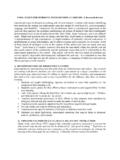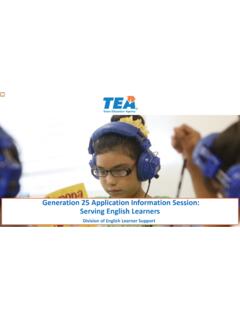Transcription of THE STAGES OF SECOND LANGUAGE ACQUISITION
1 W 2 THE STAGES OF SECOND LANGUAGE ACQUISITION e have all seen children move through the STAGES of acquiring their first LANGUAGE from babbling to one-word utterances, two-word phrases, full sentences, and eventually, complex grammar. Students learning a SECOND LANGUAGE also move through STAGES . One of the most important things you should know about each of your english LANGUAGE learners (ELLs) is which stage of ACQUISITION they are in. Knowing and understanding the stage and its characteristics are critical for effectively differentiating instruction for these students. Stephen Krashen and Tracy Terrell first explored STAGES of SECOND LANGUAGE ACQUISITION in their 1983 book, The Natural Approach. Figure lists the five STAGES of LANGUAGE ACQUISITION , along with the charac- teristics, approximate time frames, and appropriate teacher prompts for each stage. The Preproduction stage lasts from zero to six months and is also known as the silent period, because it s likely you won t hear stu- dents speak any english at all during this stage.
2 At the next level, Early Production, students begin using single words or two-word phrases, yes/no responses, names, and repetitive LANGUAGE patterns ( , How are you? ). At the Speech Emergence stage, students are able to say simple sentences ( , I walked home ). Eventually, at the Intermediate Fluency stage, students can use sentences of 14 The STAGES of SECOND LANGUAGE ACQUISITION 15 Figure STAGES of SECOND LANGUAGE ACQUISITION Stage Characteristics Approximate Time Frame Teacher Prompts Preproduction The student Has minimal comprehension Does not verbalize Nods Yes and No Draws and points 0 6 months Show me.. Circle the.. Where is.. ? Who has.. ? Early Production The student Has limited comprehension Produces one- or two-word responses Participates using key words and familiar phrases Uses present-tense verbs 6 months 1 year Yes/no questions Either/or questions One- or two-word answers Lists Labels Speech Emergence The student Has good comprehension Can produce simple sentences Makes grammar and pronun- ciation errors Frequently misunderstands jokes 1 3 years Why.
3 ? How.. ? Explain.. Phrase or short-sentence answers Intermediate Fluency The student Has excellent comprehension Makes few grammatical errors 3 5 years What would happen if.. ? Why do you think.. ? Advanced Fluency The student has a near-native level of speech. 5 7 years Decide if.. Retell.. Source: Adapted from Krashen and Terrell (1983). increasing length and complexity, until finally, at the Advanced Flu- ency stage, they demonstrate a near-native level of fluency. All students acquiring english will pass through these STAGES . Although Figure provides an approximate time frame for each stage, the length of time students spend at each level will be as varied as the students themselves. Krashen and Terrell s early work linked classroom activities with the STAGES to ensure that teachers did not expect utterances from ELLs that were beyond or beneath their STAGES of ACQUISITION . Imagine, for example, a student in the Preproduction stage being asked how or why questions or a student in the Inter- mediate Fluency stage being asked to perform a Preproduction-stage task, such as pointing to an object.
4 16 Classroom Instruction That Works with english LANGUAGE learners The so-called Ramirez Report (Ramirez, 1992) found that in all the LANGUAGE programs studied, including immersion as well as early- exit and late-exit transitional bilingual education, teachers tended to ask low-level questions. By knowing the STAGES of LANGUAGE ACQUISITION and the stage-appropriate questions, you can engage students at the correct level of discourse. In addition, when appropriate questions are asked, content knowledge can be assessed alongside LANGUAGE proficiency. Knowing the level of LANGUAGE ACQUISITION also allows you to work within the student s zone of proximal development that area between what the student is capable of at the moment and the point you want the student to reach next (Vygotsky, 1978). According to Vygotsky, you can work in a student s zone of proximal development by scaffolding LANGUAGE development, or providing the support a student needs as she progresses.
5 Scaffolding is essentially a way to nudge a student toward a higher level of performance. With LANGUAGE development, this can be done by modeling correct grammar or pronunciation, asking challenging questions, or providing direct instruction. For example, if a student is in the Preproduction stage, he will be successful at stage-appropriate tasks such as pointing, finding, or circling a picture. However, you can scaffold further development by supporting him as he attempts tasks characteristic of the Early Production stage, such as answering yes/no or either/or questions or providing one-word responses. Recognizing the level of LANGUAGE ACQUISITION is also a factor when setting LANGUAGE objectives. This can best be explained by Krashen s input hypothesis (i + 1), which builds upon the scaffolding approach described above (i = actual level and i + 1 = potential level of LANGUAGE development; Krashen & Terrell, 1983). Krashen s hypothesis states that a speaker will move to the next level of acquisi- tion when the experience of the target LANGUAGE (the input) includes some of the structures that are part of the next stage of ACQUISITION , and the speaker is encouraged to use LANGUAGE that reflects that more advanced stage.
6 Paying attention to teacher prompts that accompany the levels is one way for a student to move to the next level of english profi- ciency. If you adapt the way you prompt, students will respond according to both their current stage and the stage just beyond. A common question teachers ask is, How long does it take an english LANGUAGE learner to pass through the STAGES of LANGUAGE acqui- sition so that he can perform as well as a native english speaker in school? In answer to this question, let s take a look at Figure Picture the english LANGUAGE as an iceberg divided into two parts: conversational LANGUAGE and academic LANGUAGE . The tip of the The STAGES of SECOND LANGUAGE ACQUISITION 17 Figure Surface and Deeper Level of LANGUAGE Proficiency Cognitive Process Conversational Proficiency LANGUAGE Process Knowledge Pronunciation Comprehension Vocabulary Application Grammar Analysis Synthesis Semantic Meaning Cognitive/Academic Evaluation Proficiency Functional Meaning Source: Cummins, James.
7 Bilingualism and special education: Issues in assessment and ped- agogy. Clevedon, England: Multilingual Matters. Copyright 1984. Reprinted by permission of the the small part that is visible above water is conversational english , or basic interpersonal communicative skills. This is the lan- guage of normal everyday speech, including pronunciation, grammar, and basic vocabulary. It is the ability to understand and speak infor- mally with friends, teachers, and parents. This conversational ability is not especially demanding intellectually. It is the LANGUAGE that non- english -speaking children develop after about two years of living in an english -speaking country. Because they have developed a conversational ability, these chil- dren sound fluent to many people. They understand the teacher s questions, converse with classmates in english , and even translate for their parents. However, their daily schoolwork and exams may not reflect this fluency. Frustrated parents and teachers, faced with this contradiction, often conclude falsely that such students have learning disabilities, are poorly motivated, or are just plain lazy.
8 Let s go back to the iceberg. If we apply the iceberg metaphor to our fluent but underachieving students, we are likely to see that they have only developed the tip ( , conversational english ). They have not developed academic english the large portion of the iceberg that is hidden under the sea. Academic english , or cognitive academic LANGUAGE proficiency, is the LANGUAGE of the classroom the LANGUAGE of isosceles triangles, complex compound sentences, and photosynthesis. Students must master academic english to understand textbooks, write papers and 18 Classroom Instruction That Works with english LANGUAGE learners reports, solve mathematical word problems, and take tests. Without a mastery of academic english , students cannot develop the critical- thinking and problem-solving skills needed to understand and express the new and abstract concepts taught in the classroom. However, aca- demic LANGUAGE takes at least five to seven years to develop, and it can take even longer for a student who was not literate in her primary LANGUAGE when she started in a school (Collier & Thomas, 1989).
9 In the chapters that follow, you will find examples of instruc- tional strategies that have been modified to meet the needs of ELLs according to their LANGUAGE ACQUISITION level. You will also find exam- ples of how to engage these students in whole-class activities by asking tiered questions associated with their level of LANGUAGE acquisi- tion. Each chapter features an example of how an instructional strat- egy can be adapted for Preproduction, Early Production, Speech Emergence, and Intermediate and Advanced Fluency students. By providing stage-appropriate adaptations of instructional strategies, we hope to help you achieve the greatest possible success with your ELLs. Classroom Examples Here are examples of the kinds of adaptations you will find in the following chapters. Subject: Literacy Content Objective: To help students learn the basics of summarization. A 1st grade teacher is teaching students to summarize using a Big Book version of The Three Little Pigs.
10 She can help her ELLs acquire a better understanding of summarizing by using tiered questions in dif- ferent ways depending on the stage of the student. Preproduction Students can point to a picture in the book as the teacher says or asks: Show me the wolf. Where is the house? Early Production Students do well with yes/no questions and one- or two-word answers: Did the brick house fall down? Who blew down the straw house? Speech Emergence Students can answer why and how questions with phrases or short-sentence answers, and can also explain their answers: Explain why the third pig built his house out of bricks. The STAGES of SECOND LANGUAGE ACQUISITION 19 Intermediate Fluency Students can answer What would happen if and Why do you think questions: Why do you think the pigs were able to outsmart the wolf? Advanced Fluency Students can retell the story, including the main plot elements and leaving out the insignificant details. In addition to using tiered questions to include all students in a whole-class activity, you can also use these questioning strategies one- on-one with ELLs to check for comprehension.



